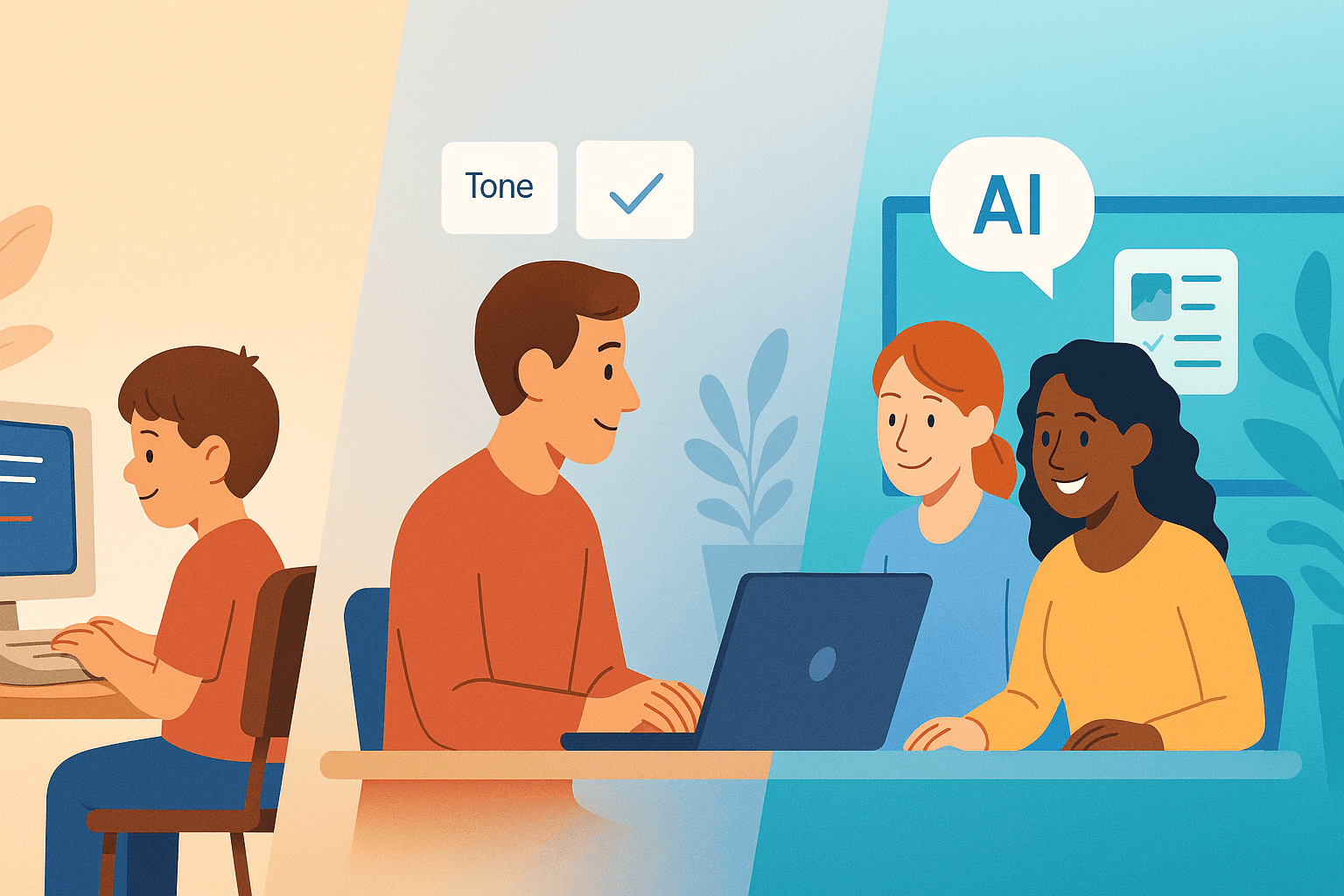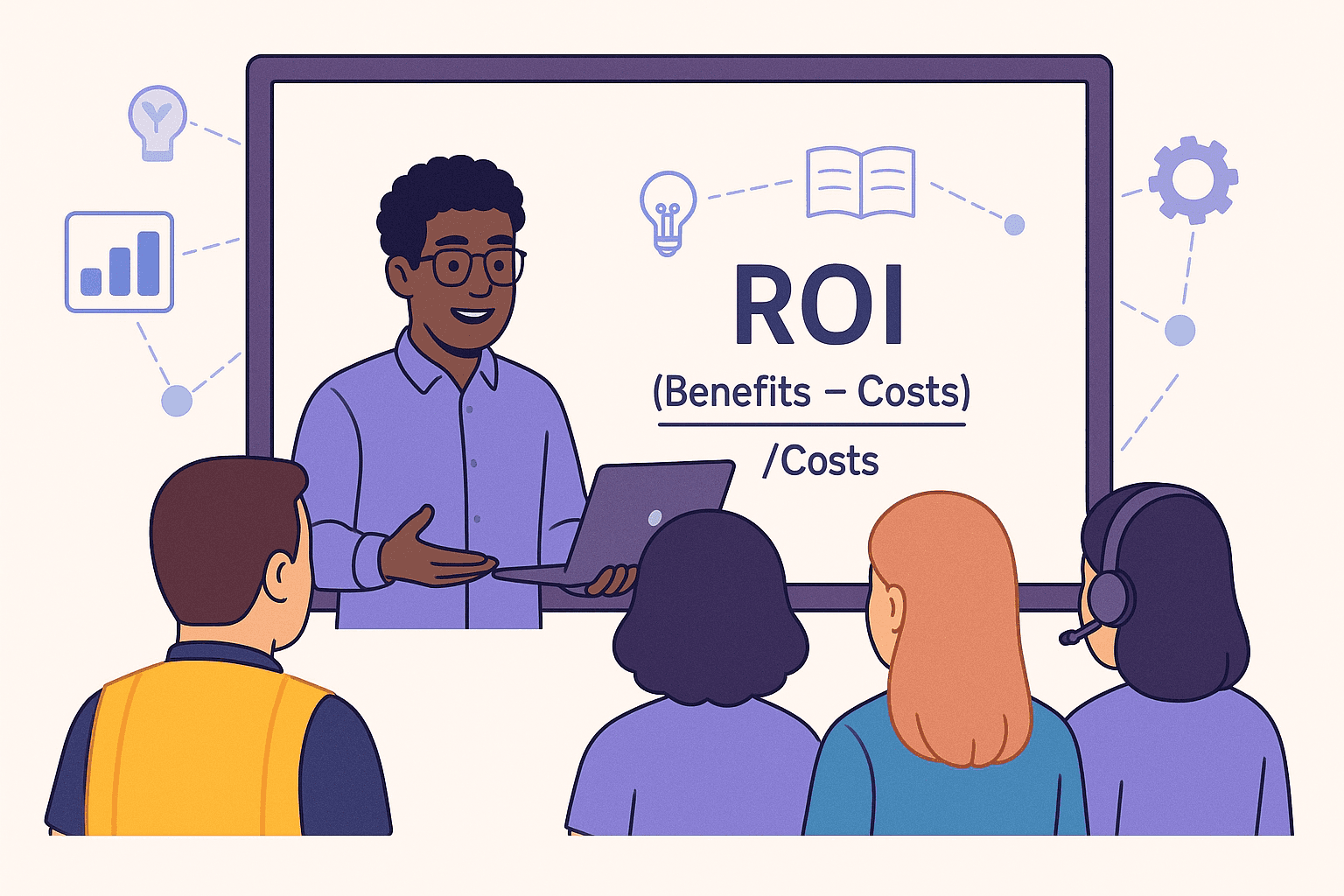3 min
17 abr 2025
¿Qué es el aprendizaje adaptativo y cómo se puede emplear?
Lara Cobing

Durante unas prácticas que me emocionaban, tuve que completar un curso de formación en línea. Algunas secciones cubrían material conocido, mientras que otras avanzaban demasiado rápido, dejando vacíos en mi comprensión. Deseaba que la formación se hubiera ajustado a mis necesidades, reforzando lo que necesitaba y omitiendo lo que ya sabía.
Muchos empleados comparten esta frustración: pasan un tiempo valioso en formaciones que no coinciden con sus necesidades o niveles de habilidad. La formación corporativa tradicional a menudo sigue un enfoque de talla única, dejando a los empleados desconectados y luchando por retener conocimientos relevantes. Las empresas invierten fuertemente en programas de formación, sin embargo, muchos no logran ofrecer mejoras medibles en el rendimiento de la fuerza laboral.
El aprendizaje adaptativo está cambiando este panorama. Al aprovechar la inteligencia artificial (IA) y los conocimientos basados en datos, el aprendizaje adaptativo personaliza las experiencias de formación para cada empleado, mejorando la participación, la retención de conocimientos y la efectividad general. Este artículo explora cómo funciona el aprendizaje adaptativo, sus beneficios y cómo las organizaciones pueden implementarlo para impulsar el éxito empresarial.
¿Qué es el Aprendizaje Adaptativo?
El aprendizaje adaptativo es un enfoque de formación que ajusta el contenido de aprendizaje en función del rendimiento, el comportamiento y las necesidades del empleado. En lugar de presentar material idéntico a todos los aprendices, las plataformas de aprendizaje adaptativo personalizan la instrucción en tiempo real. Esto significa que los empleados reciben formación relevante y dirigida que acelera la adquisición de conocimientos mientras se evita el material redundante.
Cómo Funciona el Aprendizaje Adaptativo:
Evaluación Inicial: Los aprendices comienzan con una evaluación para medir sus conocimientos y niveles de habilidad actuales.
Rutas de Aprendizaje Personalizadas: Los algoritmos impulsados por IA analizan las respuestas y ajustan el contenido de formación en consecuencia.
Retroalimentación en Tiempo Real: Los empleados reciben retroalimentación inmediata y recursos adicionales para fortalecer áreas débiles.
Ajustes Continuos: El sistema se adapta continuamente en función de las interacciones, asegurando que los aprendices se mantengan desafiados pero no abrumados.
Conocimientos Basados en Datos: Los profesionales de la formación pueden rastrear el progreso individual y del equipo, optimizando la formación a lo largo del tiempo.
Beneficios Clave del Aprendizaje Adaptativo para las Empresas
Adoptar el aprendizaje adaptativo en los programas de formación corporativa presenta numerosas ventajas. Al personalizar el contenido según las necesidades individuales, las empresas pueden optimizar el desarrollo de los empleados, fomentar la participación y crear experiencias de aprendizaje más eficientes. A continuación se presentan los beneficios clave de este enfoque.
1. Rutas de Aprendizaje Personalizadas
Los empleados reciben contenido adaptado a su nivel de habilidad específico, asegurando que interactúen con material que es relevante y útil en lugar de volver a visitar información que ya conocen.
2. Mayor Participación y Motivación
La formación tradicional puede ser monótona, pero el aprendizaje adaptativo mantiene a los empleados desafiados al nivel adecuado, haciendo que las sesiones de formación sean más interactivas y atractivas.
3. Uso Eficiente del Tiempo
En lugar de pasar horas en material que ya han dominado, los empleados se concentran en áreas donde necesitan mejorar, reduciendo el tiempo de formación mientras mejoran su competencia.
4. Retroalimentación en Tiempo Real y Conocimientos
La retroalimentación inmediata ayuda a los aprendices a reconocer errores y ajustar su enfoque al instante. Mientras tanto, los gerentes obtienen visibilidad sobre el progreso de los empleados, identificando tendencias y áreas que necesitan refuerzo.
5. Escalabilidad a lo largo de la Organización
Las plataformas de aprendizaje adaptativo se escalan fácilmente para satisfacer las necesidades de varios equipos y departamentos, asegurando consistencia sin sobrecargar los recursos de formación.
Superando Desafíos Comunes
A pesar de sus beneficios, implementar el aprendizaje adaptativo viene con obstáculos. Aquí se explica cómo navegar a través de ellos:
🚧 Desafío: Los empleados resisten nuevas tecnologías de formación.
💡 Solución: Comunica los beneficios claramente demostrando cómo el aprendizaje adaptativo ahorra tiempo, personaliza la formación y mejora el rendimiento laboral. Ofrece talleres prácticos o periodos de prueba para aumentar los niveles de confort.
🚧 Desafío: Falta de contenido adaptable y de alta calidad.
💡 Solución: Utiliza herramientas de autoría asistidas por IA para convertir materiales estáticos en cursos dinámicos e interactivos. Aprovecha los datos de la analítica del aprendizaje para refinar y actualizar el contenido basado en el compromiso y la efectividad.
🚧 Desafío: Medir el ROI del aprendizaje adaptativo.
💡 Solución: Define métricas de éxito claras, como tasas de finalización, mejora de habilidades y rendimiento empresarial vinculado a la formación. Utiliza herramientas de analítica del aprendizaje para rastrear el progreso individual y organizacional a lo largo del tiempo, ajustando las estrategias según sea necesario para una mejora continua.
Implementando Aprendizaje Adaptativo en su Organización
Para integrar con éxito el aprendizaje adaptativo en la estrategia de aprendizaje de una organización, las empresas necesitan un enfoque estructurado.
1. Identificar Necesidades Organizacionales y Objetivos de Aprendizaje
Antes de seleccionar una solución de aprendizaje adaptativo, los profesionales de la formación deben definir las competencias clave que los empleados necesitan dominar. Realiza evaluaciones de habilidades utilizando métodos como encuestas a empleados, revisiones de rendimiento y analíticas impulsadas por IA de programas de formación pasados para identificar brechas. Identificar preferencias de aprendizaje específicas y niveles de conocimiento existentes ayuda a personalizar la formación en consecuencia, asegurando una experiencia de aprendizaje más efectiva y atractiva.
2. Elegir la Plataforma de Aprendizaje Adaptativo Adecuada
No todas las soluciones de aprendizaje adaptativo son iguales. Las empresas deben evaluar las plataformas en función de los siguientes factores:
Recomendaciones de contenido impulsadas por IA: Asegura rutas de aprendizaje personalizadas según el rendimiento del empleado.
Analíticas en tiempo real: Ayuda a seguir el progreso del aprendiz e identificar áreas que necesitan refuerzo.
Integración sin problemas con LMS: Asegura compatibilidad con la infraestructura de formación existente.
Formatos de contenido multimodal: Soporta videos, cuestionarios interactivos y simulaciones para mejorar la participación.
3. Desarrollar Contenido de Formación Modular y Amigable para IA
El aprendizaje adaptativo funciona mejor cuando el contenido se estructura en formatos modulares. Dividir los materiales de formación en segmentos de microaprendizaje permite a las plataformas impulsadas por IA ajustar dinámicamente las lecciones según el progreso del aprendiz.
Mejores prácticas para el desarrollo de contenido modular:
Lecciones cortas y enfocadas: Cada módulo debe abordar un solo concepto o habilidad para mejorar la comprensión y retención.
Tipos de contenido variados: Utiliza texto, video, cuestionarios interactivos y simulaciones para acomodar diferentes preferencias de aprendizaje.
Niveles de dificultad adaptativos: Asegúrate de que la complejidad del contenido se ajuste dinámicamente según las interacciones y el progreso del aprendiz.
Al diseñar materiales de formación flexibles, las organizaciones pueden mejorar la personalización, mantener a los aprendices comprometidos y facilitar el desarrollo continuo de habilidades.
4. Pilotar, Optimizar y Escalar
Antes de implementar el aprendizaje adaptativo en toda una organización, comienza con un programa piloto. Elige un grupo pequeño y diverso de empleados para probar la plataforma y recopilar retroalimentación.
Pasos para optimizar la implementación:
Monitorear las métricas de participación y rendimiento: Seguimiento de tasas de finalización y retención del conocimiento.
Ajustar el contenido según las analíticas: Modificar las estructuras y el ritmo de las lecciones en función de las ideas basadas en datos.
Recopilar retroalimentación cualitativa: Realizar entrevistas o encuestas a empleados para comprender la experiencia del usuario.
Una vez refinado, escala el programa a través de los departamentos para maximizar el impacto y promover mejoras consistentes en el aprendizaje.
Plataformas de Aprendizaje Adaptativo a Considerar
Elegir la plataforma de aprendizaje adaptativo adecuada depende de las necesidades de su organización. Aquí hay un desglose de las opciones clave y lo que las distingue:
1. Mindsmith
Mindsmith tiene la capacidad de generar rutas adaptativas con IA en nuestra función de escenarios ramificados. Esto ayuda a personalizar las experiencias de aprendizaje, asegurando que los empleados reciban contenido relevante según su progreso. La plataforma también admite lógica condicional en las preguntas de evaluación y optimización para móviles, lo que la hace ideal para la formación dinámica en el lugar de trabajo.
2. Realizeit
Realizeit ofrece un sistema de aprendizaje totalmente adaptativo que personaliza la formación corporativa en tiempo real, ajustando el contenido según el rendimiento y el compromiso. Utilizado ampliamente en industrias como la atención médica, finanzas y manufactura, apoya el desarrollo de habilidades y la formación en cumplimiento.
3. SC Training (anteriormente EdApp, rebranded en 2023)
SC Training proporciona una herramienta de creación de cursos impulsada por IA, Crear con IA, que permite a las empresas generar programas de formación personalizados rápidamente. Su enfoque móvil y su formato de microaprendizaje interactivo lo hacen ideal para el aprendizaje en movimiento.
4. Adaptemy
Adaptemy se integra sin problemas en los ecosistemas de aprendizaje existentes, proporcionando personalización de contenido en tiempo real según las interacciones de los aprendices. Se utiliza comúnmente en industrias que necesitan una rápida actualización de habilidades y formación especializada.
5. Knewton
El motor de aprendizaje adaptativo de Knewton proporciona experiencias personalizadas al analizar continuamente el comportamiento del aprendiz, lo que lo convierte en una opción sólida para las empresas que buscan adaptar la formación de los empleados.
Estudios de Caso
Aprendizaje Adaptativo en IBM: Mejorando el Rendimiento del Equipo de Ventas
IBM necesitaba mejorar las habilidades de su equipo de ventas global para mantenerse al día con la rápida evolución de la tecnología y las demandas del mercado. Los métodos de formación tradicionales no eran suficientemente flexibles o personalizados para satisfacer las diversas necesidades de su fuerza laboral. Para abordar esto, IBM implementó el aprendizaje adaptativo para mejorar sus programas de formación de ventas. Al utilizar la personalización impulsada por IA, la empresa proporcionó a los empleados una formación dirigida, aumentando el compromiso y la retención del conocimiento. Los empleados pudieron concentrarse en las áreas donde necesitaban mejora, lo que llevó a un aprendizaje más eficiente y un rendimiento más fuerte. Este caso destaca cómo el aprendizaje adaptativo impulsado por IA puede mejorar significativamente el compromiso y el conocimiento de los empleados.
Implementación de Aprendizaje Adaptativo en un Minorista Global
Un minorista global buscó mejorar la participación y eficiencia en sus programas de formación obligatorios para 3,000 empleados. Colaborando con expertos en aprendizaje, la empresa implementó estrategias de aprendizaje adaptativo, personalizando las experiencias de formación basadas en las interacciones y el rendimiento individuales del aprendiz.
Los resultados fueron significativos: la iniciativa ahorró 391 horas de formación y pronosticó un retorno de inversión (ROI) del 600%. Estos resultados destacan el poder del aprendizaje adaptativo para optimizar los procesos de formación y generar valor empresarial.
Conclusión
A medida que las demandas de la fuerza laboral evolucionan rápidamente, las empresas deben repensar sus estrategias de formación para mantenerse competitivas. El aprendizaje adaptativo ofrece un enfoque escalable, eficiente y personalizado que asegura que los empleados reciban la formación adecuada en el momento adecuado. Al aprovechar las herramientas de aprendizaje impulsadas por IA, las empresas pueden mejorar la participación, mejorar la retención de conocimientos y fomentar el crecimiento a largo plazo.
Con el avance de la IA y los conocimientos basados en datos, el aprendizaje adaptativo se está convirtiendo en una herramienta aún más poderosa para construir fuerzas laborales ágiles y preparadas para el futuro. Para mantenerse competitivo, las organizaciones deben explorar soluciones de aprendizaje adaptativo, pilotar su implementación y empoderar a los empleados con formación impulsada por IA para un impacto duradero.



